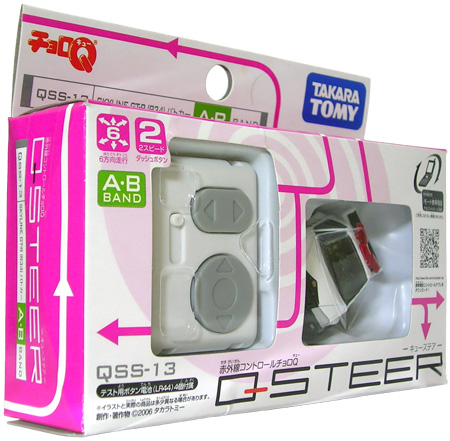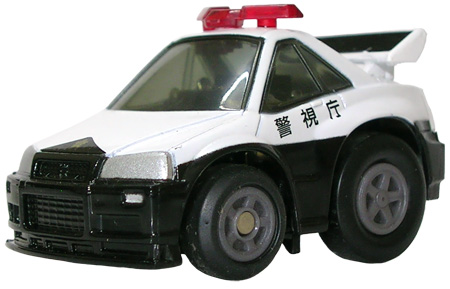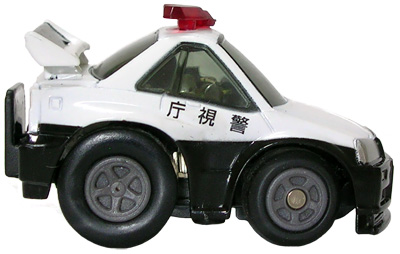I’m not much of a fan of remote-controlled vehicles. In 1981, I was presented with my first one, a 30cm-long Porsche 911. My excitement evaporated five minutes after I tried it out because the toy RC car’s limitations were quickly apparent. It could go forward. Slowly. And it could reverse in a circle. Slowly. To turn to the left or right, you had to either reverse a quarter of a circle or reverse three-quarters of a circle. Ugh.
Flash forward a quarter of a century and I have my second remote-controlled vehicle. This one is 5cm (!) long, has much better control and has working suspension to boot.
Technology, eh?
“A whole different breed of speed”
The new RC car is by Takara Tomy and it’s from the Q-Steer line. Q-Steer is an unusual name but you can glean some toy history from the name. The Q in Q-Steer refers to the Choro-Q mini-cars produced by Takara (now Takara Tomy) since 1980.
If the name Choro-Q is unfamiliar perhaps you know the line better as Penny Racers. These are cutesy toy cars with a pull-back motor and a slot in the rear that fit a coin. With the coin in the slot, the cars would pop a wheelie.
Takara has produced an extraordinary variety of products inspired by its own Choro-Q line. These include a music player, videogames and remarkably, actual cars.
Mostly, though, Takara’s Choro-Q-inspired offerings have been toys. The Transformers Mini-Bots (Bumblebee, Cliffjumper, etc.) had vehicular modes that were 1:1 scale Choro-Q cars. In 2001, Takara produced IR-controlled Choro-Q toy cars called Digi-Q.
Q line

Q-Steer is the latest toy to draw inspiration from Choro-Q. It’s much cheaper than Digi-Q and from what I gather, it’s a little slower but a little easier to control. There are better reviews by more knowledgeable RC car owners and you ought to check them out if you’re looking for comparisons and technical details. I’ll stick to providing my impressions.
The Q-Steer cars come in two basic versions: standalone (933 yen) or bundled with the controller (1280 yen). You might think that selling the car without the controller doesn’t make much sense but you’d be mistaken. You see, owners of i-Mode phones can download an applet which allows them to use their phones to control the Q-Steer car. You can also use a single controller with more than one car after switching frequencies.
Like Choro-Q, the Q-Steer cars come in various models. There’s quite a selection — everything from a Hummer to a 1958 Subaru 360. They’re all done in the same SD-style as Choro-Q but the car models are recognisable enough. My Q-Steer, QSS-13, is based on the Nissan Skyline GT-R (R34) Patrol Car.

The vehicle and the controller each require a pair of LR44 batteries. This is a better approach compared to Digi-Q since Digi-Q vehicles, which had to be recharged by the controller, would run out of juice after about 15 minutes of play. In a nice touch, Takara Tomy included test batteries so you can immediately start playing. For a while anyway.
The controller, which is scarcely larger than the car, is very simple. There are buttons for forward/backward and left-right directions. There’s also a “dash” button that provides a burst of speed. I’m not sure how long you can sustain that burst of speed and I’m not sure whether it exhausts the battery faster.
There’s also a switch to allow the controller to be used with cars of different frequencies. From what I can tell, the sets with both car and controller have A-B bands while the cars sold individually have C-D bands. There’s a switch on the bottom of the car that allows you switch frequencies.
The bottom of the controller has a piece of plastic that swings out. Described in the instructions as an adjuster stick, it serves two purposes. One is to prise open the battery compartment cover on the vehicle. The other use of the stick is to manipulate the tiny on/off switch on the vehicle’s underside.
This brings me to the only annoying thing about the Q-Steer. I found it difficult to switch the car on and often as not the adjuster stick would pop right out of the controller while I was trying to wrestle the switch into position.
The car also has a trim switch on the bottom to allow you to make steering adjustments if necessary.
In action

In terms of speed, the Q-Steer isn’t going to be breaking any speed records anytime soon. Even with dash button’s burst of speed, it’s only about, um, cockroach-in-panic speed, I guess. The Q-Steer has a turn radius of about 15cm and is manoeuvrable enough to drive around on a desk.
The instructions note the IR controller has a range of 1.5m but I found that was far too conservative an estimate and the vehicle was controllable up to four times that range.
I tested the coin holder with a 5 sen, 10 sen and 20 sen coins. The 5 sen and 10 sen coins were too light to have any effect. A 20 sen coin, on the other hand, caused the Q-Steer to lean back on its back wheels during forward motion. Note that steering is done with the front wheels so there’s no way of turning while in a wheelie.
The vehicle makes a slightly irritating whirring noise when in action. I was testing it in the kitchen when the noise attracted the attention of a gecko which was hiding under a cupboard. It rushed out to stare down the Q-Steer, dashed under a cabinet when it noticed me and then skittered out to confront the Q-Steer when toy whirred in action again. Much to my amusement, this sequence continued a few more times. I rushed upstairs to grab my digicam to capture this but naturally, the gecko refused to come out again. And that’s the story of how I almost got a Really Interesting Photo.
Back to Q-Steer. The instructions include notes for maintenance. Apparently, the wheels and gear can be removed which ought to make it easier to clear them. There are also hints that high-performance parts are available though I’ve not heard anything concrete about them. For what it’s worth, the box proclaims my Q-Steer is a “Normal Speed Type.”
Overall, it’s a fun toy. I paid almost double the Japanese retail price for mine but I consider it worth the money.
Q-Steer videos:
